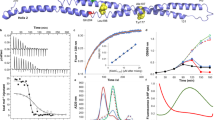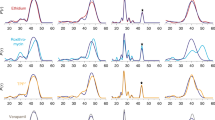Abstract
Diverse molecules, from small antibacterial drugs to large protein toxins, are exported directly across both cell membranes of Gram-negative bacteria. This export is brought about by the reversible interaction of substrate-specific inner-membrane proteins with an outer-membrane protein of the TolC family, thus bypassing the intervening periplasm. Here we report the 2.1-Å crystal structure of TolC from Escherichia coli, revealing a distinctive and previously unknown fold. Three TolC protomers assemble to form a continuous, solvent-accessible conduit—a ‘channel-tunnel’ over 140 Å long that spans both the outer membrane and periplasmic space. The periplasmic or proximal end of the tunnel is sealed by sets of coiled helices. We suggest these could be untwisted by an allosteric mechanism, mediated by protein–protein interactions, to open the tunnel. The structure provides an explanation of how the cell cytosol is connected to the external environment during export, and suggests a general mechanism for the action of bacterial efflux pumps.
This is a preview of subscription content, access via your institution
Access options
Subscribe to this journal
Receive 51 print issues and online access
$199.00 per year
only $3.90 per issue
Buy this article
- Purchase on Springer Link
- Instant access to full article PDF
Prices may be subject to local taxes which are calculated during checkout





Similar content being viewed by others
References
Thanabalu, T., Koronakis, E., Hughes, C. & Koronakis, V. Substrate-induced assembly of a contiguous channel for protein export from E. coli: reversible bridging of an inner-membrane translocase to an outer membrane exit pore. EMBO J. 17, 6487– 6496 (1998).
Paulsen, I. T., Park, J. H., Choi, P. S. & Saier, M. H. A family of Gram-negative bacterial outer membrane factors that function in the export of proteins, carbohydrates, drugs and heavy metals. FEMS Microbiol. Lett. 156, 1–8 (1997).
Koronakis, V., Koronakis, E. & Hughes, C. Isolation and characterisation of the C-terminal signal directing export of E. coli hemolysin across both bacterial membranes. EMBO J. 8, 595–605 (1989).
Koronakis, V., Hughes, C. & Koronakis, E. Energetically distinct early and late stages of HlyB/HlyD-dependent secretion across both Escherichia coli membranes. EMBO J. 10, 3263–3272 ( 1991).
Duong, F., Eichler, J., Price, A., Leonard, M. R. & Wickner, W. Biogenesis of the Gram-negative bacterial envelope. Cell 91, 567–573 (1997).
Glaser, P., Sakamoto, H., Bellalou, J., Ullmann, A. & Danchin, A. Secretion of cyclolysin, the calmodulin-sensitive adenylate cyclase-hemolysin bifunctional protein of Bordella pertussis . EMBO J. 7, 3997–4004 (1988).
Koronakis, V. & Hughes, C. Bacterial signal peptide-independent protein export: HlyB-directed secretion of hemolysin. Sem. Cell Biol. 4, 7–16 ( 1993).
Gilson, L., Mahanty, H. K. & Kolter, R. Genetic analysis of an MDR-like export system: the secretion of colicin V. EMBO J. 9, 3875– 3894 (1990).
Nikaido, H. Multidrug efflux pumps of Gram-negative bacteria. J. Bacteriol. 178, 5853–5859 ( 1996).
Zgurskaya, H. I. & Nikaido, H. Bypassing the periplasm: reconstitution of the acrA/B multidrug efflux pump of Escherichia coli. Proc. Natl Acad. Sci. USA 96, 7190–7195 (1999).
Stone, B. J. & Miller, V. L. Salmonella enteritidis has a homolog of TolC that is required for virulence in BALB/C mice. Mol. Microbiol. 17, 701–712 (1995).
Koronakis, V., Li, J., Koronakis, E. & Stauffer, K. Structure of TolC, the outer-membrane component of the bacterial type I efflux system, derived from two-dimensional crystals. Mol. Microbiol. 23, 617–626 (1997).
Sharff, A. J., Koronakis, E., Luisi, B. & Koronakis, V. Oxidation of selenomethionine: Some MADness in the method! Acta Crystallogr. D 56, 785–788 ( 2000).
Benz, R., Maier, E. & Gentshev, I. TolC of Escherichia coli functions as an outer membrane channel. Zentralbl. Bakteriol. 278, 187–196 (1993).
Lupas, A. Predicting coiled-coil regions in proteins. Curr. Opin. Struct. Biol. 7, 388–393 ( 1997).
Johnson, J. M. & Church, G. M. Alignment and structure prediction of divergent protein families: periplasmic and outer membrane proteins of bacterial efflux pumps. J. Mol. Biol. 287, 695–715 (1999).
Pautsch, A. & Schulz, G. E. Structure of the outer membrane protein A transmembrane domain. Nature Struct. Biol. 5, 1013–1017 (1998).
Schirmer, T. et al. Structural basis for sugar translocation through maltoporin channels at 3.1Å resolution. Science 267, 512–514 (1995).
Cowan, S. W. et al. Crystal structures explain functional properties of two E. coli porins. Nature 358, 727– 733 (1992).
Kreusch, A. et al. Structure of the membrane channel porin from Rhodopseudomonas blastica at 2.0 Å resolution. Protein Sci. 3, 58–63 (1994).
Snijder, H. J. et al. Structural evidence for dimerization-regulated activation of an integral membrane phospholipase. Nature 401, 717–721 (1999).
Buchanan, S. K. et al. Crystal structure of the outer membrane active transporter FepA from Escherichia coli. Nature Struct. Biol. 6, 56–63 (1999).
Locher, K. P. et al. Transmembrane signalling across the ligand-gated FhuA receptor: crystal structures of free and ferrichrome-bound states reveal allosteric changes. Cell 95, 771–778. (1998).
Ferguson, A. D. et al. Siderophore-mediated iron transport: Crystal structure of FhuA with bound lipopolysaccharide. Science 282, 2215–2220 (1998).
Schulz, G. E. Porins: general to specific, native to engineered passive pores. Curr. Opin. Struct. Biol. 6, 485–490 (1996).
Seo, J. & Cohen, C. Pitch diversity in α-helical coiled coils. Proteins Struct. Funct. Genet. 15, 223–234 (1993).
Crick, F. H. C. The packing of α-helices: simple coiled coils. Acta Crystallogr. 6, 689–697 ( 1953).
Oas, T. G. & Endow, S. A. Springs and hinges: dynamic coiled coils and discontinuities. Trends Biochem. Sci. 19, 51–54 (1994).
Unwin, N. Acetylcholine receptor channel imaged in the open state. Nature 373, 37–43 ( 1995).
Schatz, G. & Dobberstein, B. Common principles of protein translocation across membranes. Science 271, 1519–1526 (1996).
Otwinowski, Z. & Minor, W. Processing of X-ray diffraction data collected in oscillation mode. Methods Enzymol. 276, 307–326 ( 1997).
Terwilliger, T. C. & Berendzen, J. Automated structure solution for MIR and MAD. Acta Crystallogr. D 55, 849–861 (1999).
delaFortelle, E. & Bricogne, G. Maximum-likelihood heavy-atom parameter refinement in the MIR and MAD methods. Methods Enzymol. 276, 472–494 ( 1997).
Collaborative Computer Project No. 4. The CCP4 suite: programs for protein crystallography. Acta Crystallogr. D 50, 760–763 ( 1994).
Cowtan, K. in Joint CCP4 and ESF-EACBM Newsletter on Protein Crystallography Vol. 31 34–38 (Daresbury Laboratory, Daresbury, UK, 1994).
Brünger, A. T. et al. Crystallography and NMR system: a new software suite for macromolecular structure determination. Acta Crystallogr. D 54, 905–921 (1998).
Perrakis, A., Sixma, T. K., Wilson, K. S. & Lamzin, V. S. wARP: improvement and extension of crystallographic phases by weighted averaging of multiple refined dummy atomic models. Acta Crystallogr. D 53, 448–455 (1997).
Bricogne, G. Direct phase determination by entropy maximation and likelihood ranking: status report and perspectives. Acta Crystallogr. D 49, 37–60 (1993).
Carson, M. Ribbons. Methods Enzymol. 277, 493– 505 (1997).
Nicholls, A., Sharp, K. A. & Honig, B. Protein folding and association: insights from the interfacial and thermodynamic properties of hydrocarbons. Proteins Struct. Funct. Genet. 11, 281–296 (1991).
Acknowledgements
We thank A. Thompson, K. Henderson, N. Duke, A. Joachimiak, Z. Otwinowski, W. Minor, K. Phillips, M. Symmons and F. von Delft for help during data collection and discussions; C. Calladine, M. Perutz, J. Li and C. Andersen for discussions; and G. Bricogne and P. Roversi for help with the BUSTER program. We acknowledge support for EU facility access for data collection at DESY (Hamburg) and ESRF (Grenoble). This work is supported by a Medical Research Council Programme grant (to V.K. and C.H.). A.S. and B.L. are supported by the Wellcome Trust.
Author information
Authors and Affiliations
Corresponding author
Supplementary information
Supplementary Information
Supplementary Information (PDF 459 kb)
Rights and permissions
About this article
Cite this article
Koronakis, V., Sharff, A., Koronakis, E. et al. Crystal structure of the bacterial membrane protein TolC central to multidrug efflux and protein export. Nature 405, 914–919 (2000). https://doi.org/10.1038/35016007
Received:
Accepted:
Issue Date:
DOI: https://doi.org/10.1038/35016007
This article is cited by
-
Pore-forming Esx proteins mediate toxin secretion by Mycobacterium tuberculosis
Nature Communications (2021)
-
Toxin import through the antibiotic efflux channel TolC
Nature Communications (2021)
-
High-Yield Preparation of Outer Membrane Protein Efflux Pumps by in Vitro Refolding is Concentration Dependent
The Journal of Membrane Biology (2021)
-
A carotenoid-deficient mutant of the plant-associated microbe Pantoea sp. YR343 displays an altered membrane proteome
Scientific Reports (2020)
-
RNase E-dependent degradation of tnaA mRNA encoding tryptophanase is prerequisite for the induction of acid resistance in Escherichia coli
Scientific Reports (2020)
Comments
By submitting a comment you agree to abide by our Terms and Community Guidelines. If you find something abusive or that does not comply with our terms or guidelines please flag it as inappropriate.



